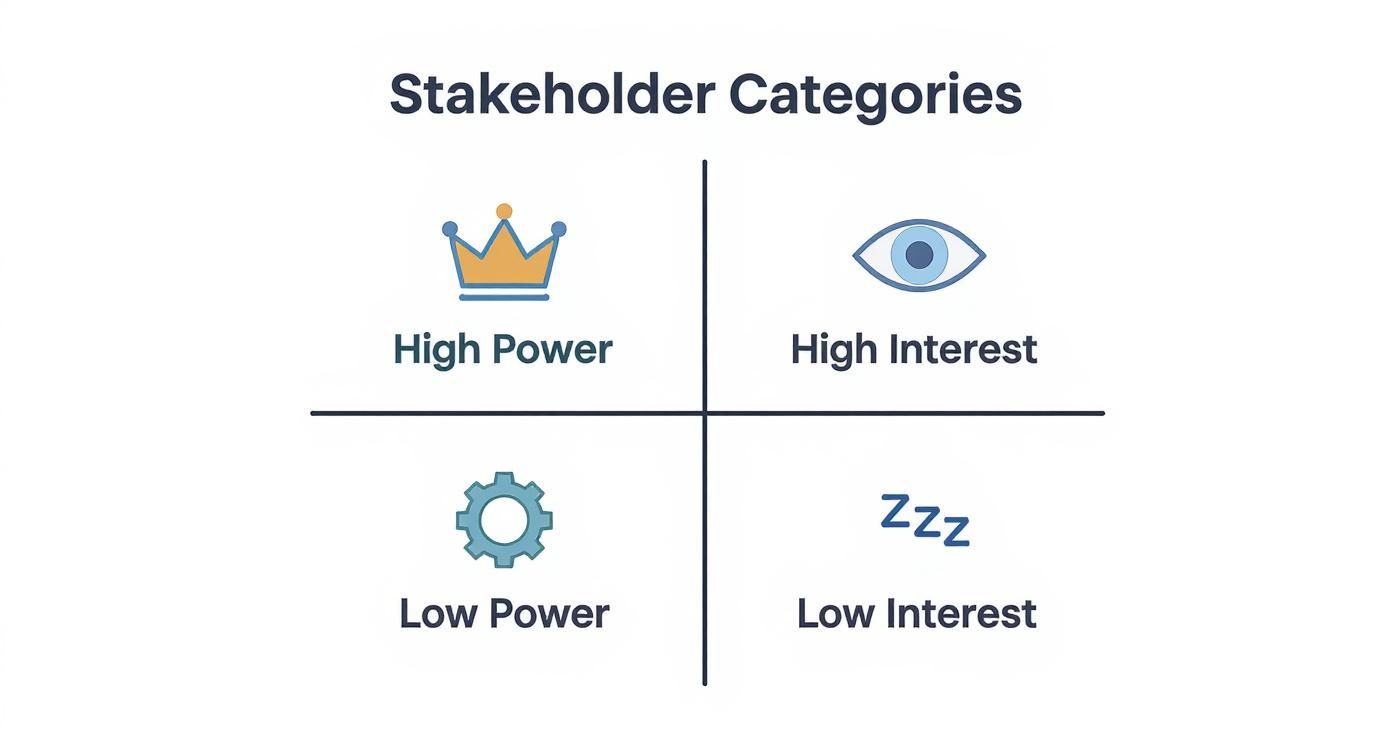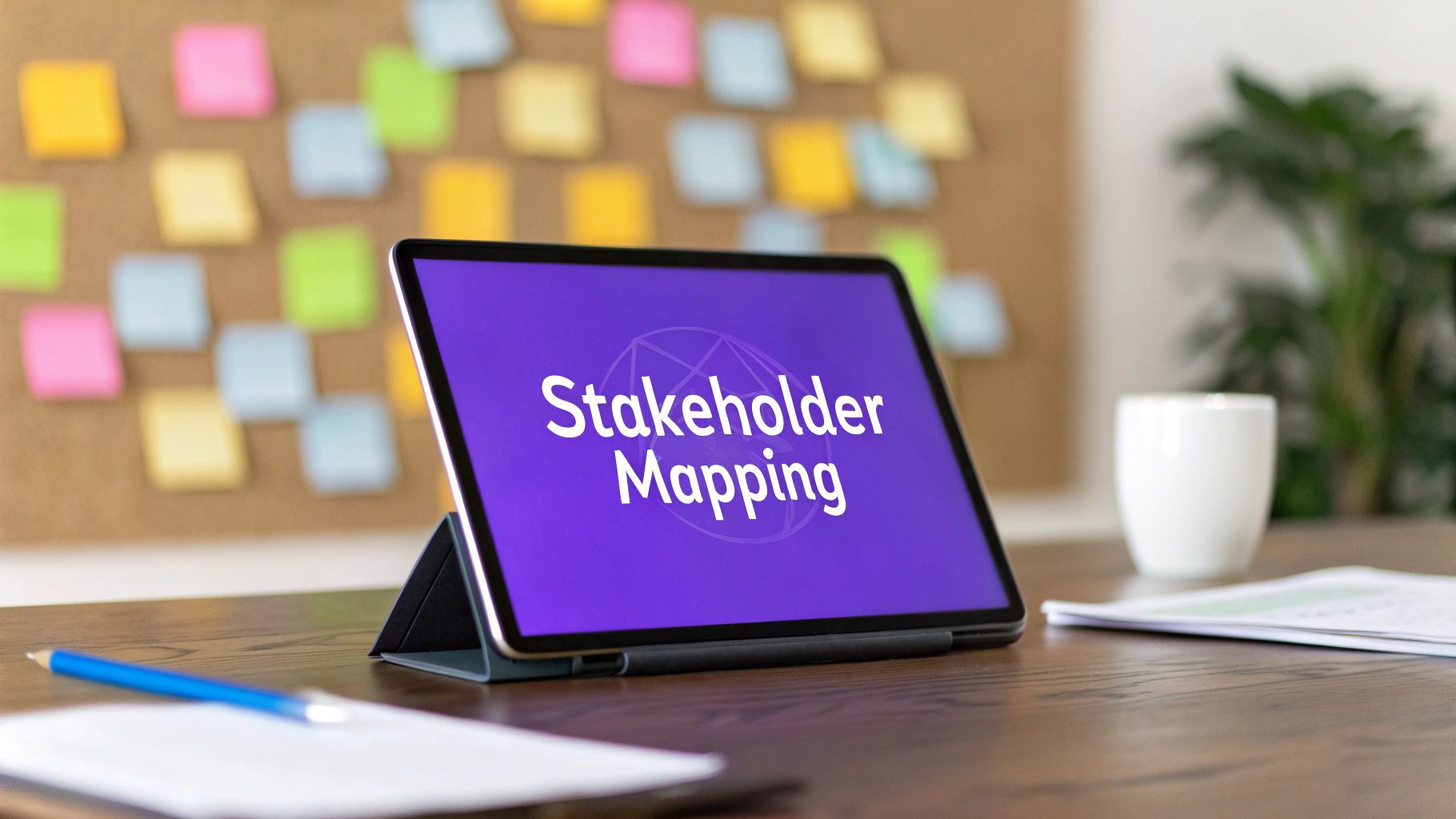Ever wonder why some projects sail smoothly to the finish line while others get stuck in endless debates and unforeseen roadblocks? The secret often lies in understanding the people involved—not just your team, but everyone who has a stake in the outcome. This is where stakeholder mapping comes in.
It’s the process of visually identifying and organizing everyone connected to your project. Think of it less as a simple list of names and more as a strategic blueprint that helps you understand their influence, their interests, and how they all connect.
Understanding Stakeholder Mapping and Why It Matters

Imagine trying to navigate a new city without a map. You might get to your destination eventually, but you'd likely hit dead ends, take wrong turns, and waste a lot of time. Stakeholder mapping is your project's social GPS. It shows you the terrain, points out potential obstacles, and helps you chart the most efficient route forward.
This process goes way beyond a typical org chart. It's about getting a real feel for the human landscape of your project so you can build the right alliances, anticipate friction before it starts, and make sure your goals resonate with the very people who can champion them.
From Confusion to Clarity
Let's say you're opening a new coffee shop in your neighborhood. Without a stakeholder map, you might just focus on your investors and employees. But a map forces you to see the bigger picture, revealing a whole ecosystem of people:
- Excited future customers who can't wait for their morning latte (High Interest, Low Power)
- The city permit office that has the final say on your opening date (High Power, Variable Interest)
- A competing café down the street that's watching your every move (High Interest, Medium Power)
- The local coffee bean supplier whose reliability is key to your quality (Medium Interest, Medium Power)
All of a sudden, you have clarity. You know who you need to win over, who just needs a quick update, and where you might run into trouble. This simple visual exercise is the foundation of solid project management best practices.
A stakeholder map isn’t just a diagram; it's a strategic guide for communication and relationship-building. It translates complex human dynamics into a manageable framework, allowing teams to navigate their project environment with confidence and purpose.
The importance of this clarity is hard to overstate. When you consider that roughly 70% of projects fail because of poor stakeholder management, you start to see just how critical this step is. Mapping out your key players helps you avoid nasty surprises and manage everyone's expectations right from the start.
Ultimately, the goal is to create a communication plan that actually works. Knowing whether someone needs a detailed report or just a quick email update is essential for effective communication in business. This targeted approach saves time, builds trust, and keeps your project humming along.
The table below breaks down the core benefits of this process.
Core Benefits of Effective Stakeholder Mapping
This table summarizes the primary advantages of implementing stakeholder mapping in any project or initiative.
| Benefit | Impact on Project Success |
|---|---|
| Increased Project Buy-In | By engaging key players early, you build a coalition of supporters who want the project to succeed. |
| Proactive Risk Management | You can identify potential opponents or obstacles and develop strategies to address them upfront. |
| Improved Communication | Tailoring your messaging to each group ensures everyone receives the right information. |
| Clearer Decision-Making | Understanding who has influence helps you navigate the approval process more effectively. |
| Better Resource Allocation | You can focus your time and energy on the relationships that will have the biggest impact. |
In short, investing time in stakeholder mapping at the beginning of a project pays off tenfold by creating a smoother, more predictable path to success.
The Four Key Stakeholder Categories to Know
So, you’ve got your list of stakeholders. Now what? The biggest mistake I see people make is trying to treat everyone the same. That’s a surefire way to burn yourself out and get nowhere fast. A much better strategy is to figure out where to focus your limited time and energy.
One of the most practical tools for this is the power/interest grid. It’s a simple 2×2 matrix that helps you sort stakeholders based on two key things: their power to impact your project and their level of interest in its success. Instead of staring at a long list of names, this grid gives you a visual map and a clear plan of action.
By plotting everyone on this grid, you’ll see four distinct groups emerge. Each one needs a completely different approach.
High Power, High Interest
These are your key players. You need to manage them closely. They have the authority to make or break your project and a deep, personal stake in its outcome. Think of them as your project’s co-pilots.
- Who they are: This is usually your executive sponsor, a major investor, or the primary client.
- How to engage them: Keep them in the loop constantly. Involve them in major decisions, set up regular one-on-one check-ins, and give them detailed updates. Your job is to keep them fully engaged and happy. If you lose their support, you risk losing everything.
High Power, Low Interest
This group needs to be kept satisfied. They have a lot of influence but aren't wrapped up in the daily grind of your project. They might be a C-suite executive or the head of a department whose approval you need, but they’ve got a dozen other things on their plate.
The trick here is that their interest can spike at any moment, so you need to keep them on your side without flooding their inbox.
- Who they are: Senior leaders not directly involved, heads of departments like legal or finance, or maybe even a regulatory body.
- How to engage them: Give them the executive summary, not the novel. Keep your updates concise and high-level. Make sure their core needs are met and consult them when a decision touches their turf, but always be respectful of their time.
Low Power, High Interest
These people are your cheerleaders. Your goal is to keep them informed. They might not have the power to greenlight a budget or veto a decision, but their support and feedback are gold. This group is often made up of the people who will actually use your product or team members in other departments who are curious about your work.
Their excitement can build incredible momentum for your project. But if they feel ignored, their grumbling can create a constant, low-level buzz of negativity that really slows things down.
Remember, this group is diverse. Taking a moment to understand the different communication styles at work will help you tailor your message and make sure it lands well.
- Who they are: End-users, junior staff on other teams, or local community groups.
- How to engage them: Think broader communication channels. Newsletters, group demos, or all-hands updates work well. Create easy ways for them to give feedback so they feel heard and valued.
Low Power, Low Interest
And finally, we have the group that requires the least amount of effort. Just monitor them. They have very little influence and aren't particularly interested in what you're doing, so there's no need to bombard them with information.
- Who they are: Often the general public, departments with no connection to your project, or vendors who play a very minor role.
- How to engage them: Minimal effort is the name of the game. A quick mention in a company-wide newsletter every now and then is more than enough.
How to Create Your First Stakeholder Map
Alright, you get the theory. Now it’s time to roll up our sleeves and actually build your first stakeholder map. This isn't some dry, academic exercise—it's a hands-on process that gives you a crystal-clear view of your project's human landscape. The best tool for the job is the Power/Interest Grid, and we'll walk through building one in four simple steps.
There's a reason this method is so popular. A recent survey revealed that about 80% of project managers lean on stakeholder mapping to figure out who to focus on. It’s a go-to technique because, frankly, it just works. You can get more background from this in-depth project management overview.
Step 1: Brainstorm Your Stakeholders
First things first: you need a list of everyone who has a stake in your project. Don't hold back or start filtering yet. The goal here is to get every single person, group, and department down on paper. Think big and cast a wide net.
To get the ball rolling, gather your team and ask a few key questions:
- Who is directly on the hook? (Think project team, sponsors, the client.)
- Who feels the ripple effects? (This could be end-users, other departments, or even local community groups.)
- Who has the final say? (Executives, regulatory bodies, and investors come to mind.)
- Who could stop this thing in its tracks? (Don’t forget legal, compliance, or key department heads.)
This brainstorming session is perfect for a team workshop. Using tools like affinity diagrams can help organize these ideas and make sure no one important falls through the cracks.
Step 2: Assess Each Stakeholder's Power
Once you have your master list, it’s time to analyze how much influence each person has over the project. Power isn't just about job titles; it can come from all sorts of places.
Think about whether a stakeholder can free up resources, kill a budget, make a critical decision, or just generally change the project’s direction. Go down your list and give everyone a simple "high" or "low" power rating.
Key Question: Can this person or group directly help or hurt the project's progress? If it's a hard "yes," they've got high power.
Step 3: Gauge Their Level of Interest
Next up is figuring out how much each stakeholder actually cares about what you’re doing. How much will the project's outcome affect their world? Are they constantly asking for updates, or are they pretty much indifferent?
If your project will directly change someone's day-to-day work, that's a huge sign of high interest. Same goes for anyone whose performance is measured by your project's success. Assign a "high" or "low" interest rating to each stakeholder.
Step 4: Plot Them on the Grid
You've done the hard work. Now for the payoff. Take your power and interest ratings and start placing each stakeholder onto a simple 2×2 grid. This single visual will instantly sort everyone into four clear-cut categories, showing you exactly how to engage with them.
This visual map brings it all together, breaking down the four quadrants based on the power and interest levels you just figured out.

This map becomes your strategic guide. It tells you exactly where to invest your energy and communication efforts to keep your project moving forward smoothly.
Turning Your Map into an Engagement Strategy
A stakeholder map is more than just a clever diagram—it's your blueprint for action. The real magic happens when you use its insights to build a solid communication plan. Without that next step, your map is just a picture. It’s by deciding on specific tactics for each quadrant that you turn your analysis into a living, breathing engagement strategy.
This is where you shift from simply knowing who your stakeholders are to figuring out how you'll build and maintain those critical relationships. Each group on your Power/Interest Grid needs a different touch, tailored to their unique mix of influence and interest.
High Power and High Interest Stakeholders
Think of this as your 'Manage Closely' quadrant. These people are the lifeblood of your project, and they deserve your most focused attention. They don't just need updates; they need to be treated like true partners.
Your strategy here has to be all about collaboration and frequent, personal communication.
- Collaborative Workshops: Get them in the room for key decisions. This ensures their vision is baked into the project's DNA from the start.
- Weekly One-on-Ones: Set up regular, personal check-ins to talk through progress, tackle concerns head-on, and gather feedback in a trusted space.
- Direct Access: Give them a direct line for anything urgent. This builds a powerful sense of partnership and trust.
High Power and Low Interest Stakeholders
For the 'Keep Satisfied' group, it's all about efficiency. These stakeholders have the influence to derail your project but don't have the time or desire to get bogged down in the details. Your job is to give them just enough information to feel confident without flooding their inbox.
Respecting their time is the single best way to keep them on your side. Give them the high-level summary, not the 50-page report.
This is about providing concise, impactful information that lets them stay in the loop with minimal effort. Clear communication is especially vital during any kind of organizational shift, a skill you can sharpen by mastering change management communication.
Low Power and High Interest Stakeholders
Welcome to the 'Keep Informed' quadrant. This group is your cheering section—the advocates and allies who are genuinely excited about what you're doing, even if they don't have final sign-off authority. Keeping them engaged is how you build invaluable grassroots support and positive buzz.
The best tactics for this group are broader, community-focused communication efforts:
- Regular Newsletters: Send out periodic updates celebrating project milestones, sharing success stories, and highlighting what's next.
- Town Halls or Webinars: Host open forums where they can ask questions directly to the project team and feel heard.
- Community Forums: Set up a dedicated Slack channel or similar space where they can connect, share ideas, and build a sense of community around the project.
Now that we've broken down each group, let's put it all together. The table below offers a quick-reference guide to match each quadrant with the right engagement approach.
Stakeholder Engagement Strategies by Quadrant
| Quadrant (Power/Interest) | Engagement Strategy | Example Action |
|---|---|---|
| High Power / High Interest | Manage Closely | Schedule weekly one-on-one meetings; involve in key workshops. |
| High Power / Low Interest | Keep Satisfied | Send concise, high-level email summaries; present at board meetings. |
| Low Power / High Interest | Keep Informed | Distribute a monthly newsletter; host an all-hands town hall. |
| Low Power / Low Interest | Monitor | Include a brief mention in a company-wide update; no direct outreach needed. |
Using this as a cheat sheet can help you stay consistent and effective in your outreach.
Finally, for the 'Monitor' group (Low Power/Low Interest), a light touch is all you need. Minimal, passive communication—like a quick mention in a company-wide memo—is plenty. It keeps them in the loop without creating unnecessary noise. For a deeper look at tailoring your approach, you can explore these powerful stakeholder engagement strategies.
Stakeholder Mapping in the Real World

It’s one thing to talk about frameworks and grids, but it's another to see them work in practice. The real magic happens when you see how stakeholder mapping turns a messy, abstract list of people into a clear, actionable plan. Let's walk through a couple of real-world examples to see how it's done.
From Blueprint to Public Park
Picture a construction company, "Oakridge Builders," that just won a bid to build a new community park. Sounds straightforward, right? But the list of people with a stake in this project is surprisingly long: the city council, nearby residents, an environmental group, their own material suppliers, and the landscape architect.
If Oakridge tried to give everyone the same amount of attention, they'd be pulled in a dozen different directions at once. It would be a recipe for chaos.
This is where the Power/Interest Grid comes in and makes sense of it all:
- City Council (High Power/High Interest): These are the key players. They hold the purse strings and the permits. The strategy? Oakridge needs to "Manage Them Closely" with bi-weekly meetings and get their sign-off on major decisions.
- Environmental Group (High Power/Low Interest): This group doesn't care about the playground design, but they have the clout to stop the project if they find an issue with a protected plant species. Oakridge’s plan is to "Keep Them Satisfied" by sending over environmental reports before they ask and inviting them for site inspections.
- Local Residents (Low Power/High Interest): While they can't shut down construction, their happiness is crucial for the park's success. The game plan here is to "Keep Them Informed" with community newsletters and a public forum to gather feedback on the design.
- Material Suppliers (Low Power/Low Interest): They have a simple job: deliver materials on time. Oakridge will just "Monitor" them through standard purchase orders and check-ins.
Suddenly, Oakridge has a concrete communication strategy that helps them prevent delays and build genuine community support.
Launching a Major Software Update
Now let's switch gears to a tech company, "Innovate Software," about to roll out a huge update. Their stakeholders are a mix of internal teams and external customers, and mapping them out is just as critical.
Key Takeaway: A stakeholder map isn't just a chart to file away. It's your strategic playbook—it tells you who needs your full attention, who just needs a heads-up, and who should be your partner in getting the project done.
For Innovate, the engineering team lands squarely in the "High Power/High Interest" quadrant; they need to be managed closely every single day. The sales team is also "High Power" but has less interest in the technical nitty-gritty. They need to be "Kept Satisfied" with clear talking points, not dragged into daily code reviews.
What about their big enterprise clients? They are "Low Power/High Interest." The best approach is to "Keep Them Informed" through early access beta programs and special webinars. To do this well, Innovate needs to understand what these clients actually care about, which is why it’s so important to learn how to conduct user research effectively.
In both of these scenarios, from building a park to updating software, the map provides the clarity needed to handle complex relationships, focus energy where it matters most, and drive the project to a successful finish.
Common Questions About Stakeholder Mapping
Even with a solid plan, you're bound to run into questions when you start stakeholder mapping for real. Getting straight answers to these common sticking points can give you the confidence to move forward and fine-tune your process. Let's tackle some of the questions I hear most often.
The beauty of this process is how adaptable it is. For example, in climate policy, you might map stakeholders based on how closely their views align with your organization's climate goals. It really shows how flexible the framework can be. You can see more examples of how different industries use this technique over at 6sigma.us.
How Often Should I Update My Stakeholder Map?
Your stakeholder map isn't something you create once and then file away. Think of it as a living document. It has to evolve right alongside your project and the people involved, otherwise, it quickly becomes useless.
For most projects, a quarterly review is a good rule of thumb. That said, you need to update it immediately whenever something big happens.
- A major change in the project's scope or budget.
- A key leader leaves or a new major investor comes on board.
- You get a piece of feedback so significant it completely changes a stakeholder's position.
If you're on a fast-paced project, you might even need to revisit it monthly or every couple of weeks. The goal is for your map to always reflect the current reality.
What Is the Difference Between Mapping and Analysis?
People throw "stakeholder mapping" and "stakeholder analysis" around as if they're the same thing, but they’re actually two distinct steps in a larger process. Knowing the difference will make your workflow much clearer.
Stakeholder analysis is the homework phase. It's all the research you do to figure out who your stakeholders are in the first place and gather information on their interests, level of influence, and how they might impact your work.
Stakeholder mapping is the visualization phase. This is where you take all that data from your analysis and plot it onto a visual tool, like the Power/Interest Grid, so you can see the big picture and decide what to do next.
Put simply, the analysis tells you "who and what," while the map shows you "so what?" The map is the strategic, visual payoff for all your analytical legwork.
Can This Be Used for More Than Just Projects?
Absolutely. While it’s a classic tool in project management, stakeholder mapping is useful for pretty much any situation where you're juggling relationships with different groups who all want different things.
It’s a go-to tool in:
- Public Relations for managing brand perception and crafting the right message.
- Product Management to make sure new features actually meet user needs and market expectations.
- Organizational Change to help transitions go smoothly by identifying who will champion the change and who might push back.
Anytime you need to understand and navigate a complex web of people, a stakeholder map will bring much-needed clarity.
Ready to bring this level of clarity to your own team's brainstorming sessions? Bulby provides a guided, AI-powered platform that helps remote teams generate and refine ideas collaboratively, ensuring every voice is heard. Transform your virtual collaboration and unlock your team's creative potential. Start your journey with Bulby today.

